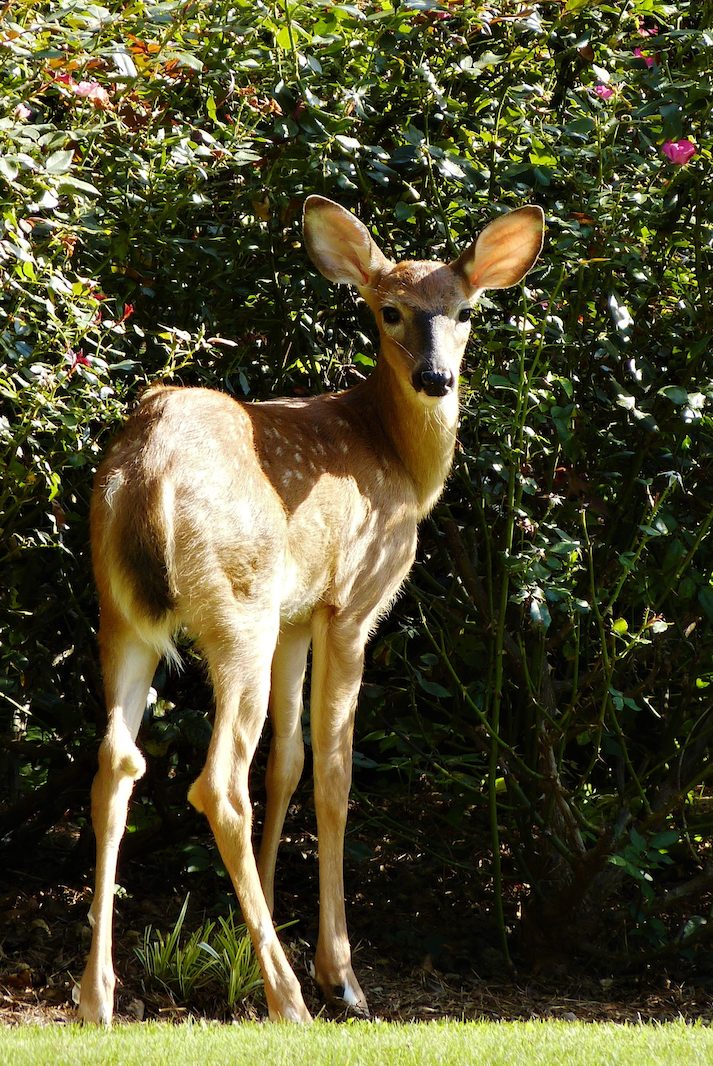When a few gardeners get together, it doesn’t take long for the topic to turn to deer control. White-tailed deer are overly-abundant and thriving in our state and in our yards. While most of us enjoy wildlife, we’d appreciate deer more if they were eating someplace other than our gardens!
There are many methods for deterring deer. Your success rate will be directly related to the severity of your problem. If you have a small or moderate deer problem, some of the controls suggested may work for you, at least for a while. If your landscape is a deer highway or rest stop, (or you have a neighbor who is feeding the deer), you may need to learn to tolerant a certain level of damage or spend the money for a tall fence!
Here are a few ideas to deer-proof your landscape…
Fencing: If multiple deer are gathering daily in your yard to enjoy your garden buffet, you may want to consider fencing the entire yard. Deer can jump high; therefore, your fence should be at least 8 feet high. Several companies offer deer fencing kits, including “invisible” mesh fencing options and electrified fencing. Two companies to research are Critter Fence and Deer Busters. Check zoning regulations and CC&Rs before erecting a fence. If fencing the entire yard is not practical, try just fencing around your prized plants, trees or vegetable garden, using chicken wire or stakes and netting.
Scare Tactics: Deer startle easily. Unexpected sounds and movement encourage deer to avoid your landscape. Wind chimes, pinwheels, twirlers, flags and whirlygigs are simple and inexpensive devices to place around your plants to provide a distraction. Hanging mirrors can startle a deer when it sees reflections. Deer can quickly become accustomed to these tactics, however, so combine them with other control methods. Dogs also do a wonderful job of scaring these critters out of your yard!
If you want to get more “high tech,” try one or more commercial products that claim to scare away deer and provide a chemical-free solution. Motion-activated lights can startle deer at night and encourage them to move away from the lighted areas. Motion-activated sprinklers attached to your garden hose can be tripped by deer and blast them with a high-power stream of water. Ultrasonic deer repellent devices use high-frequency, inaudible sounds to discourage deer from seeking out your garden.
Home Remedy Repellents: Home remedies are inexpensive and worth trying. A good offense (offensive smells or tastes) is a good defense against deer damage. Some home remedies may work for a while, until the deer become accustomed to the smell or taste, so it is best to vary your repellents. Many gardeners have had success mixing their own noxious egg spray.
The Georgia Department of Natural Resources shares its recipe:
-
- 4-6 raw eggs mixed with one gallon of water and sprayed directly on plants.
- For a more intense spray, mix 6-12 rotten eggs with one gallon water, one cup liquid soap or shampoo, 2 cloves garlic, 2 tbsp. cayenne pepper and 2 tbsp Tabasco sauce. Strain and test first before spraying all your plants.
Sprinkling urine from predators (dogs, coyotes, humans) around plants can be a deterrent, as well as sprinkling shaved soap or tucking fabric softener sheets around your plants. Hanging mesh bags or panty hose filled with human, dog or cat hair or hanging soap (Irish Spring or Dial) have worked for some. Other people suggest using dirty diapers, used cat litter and unwashed athletic socks as deterrents! (Yikes!) These may discourage any animal or human from coming into your garden!
Deer supposedly don’t like to walk on uneven spaces, so try placing chicken wire on the ground around your plants. Milorganite, a slow-release fertilizer made from composted sewage, and blood meal, a slow-release source of nitrogen, have both been used effectively as repellents when sprinkled around plants.
Commercial Repellents: My informal survey of local gardeners indicates that Liquid Fence Deer and Rabbit Repellent has many fans. This product, containing eggs and garlic, is sold in concentrate form, mixed with water and sprayed on plants. For best results, follow manufacturer’s instructions and apply again after a hard rain. Other commercial repellents include Bobbex Deer Repellent, Deer Out and Deer Off.
Wireless deer repellent posts contain a sweet scent when positioned around plants. When the deer investigate the scent, they receive a harmless shock that encourages them to leave the area. Many gardeners are enthusiastic about this product.
Deer-Resistant Plants: There is no such thing as a completely deer-proof plant. Deer will eat just about any plant when they are hungry. But, when they have a nice selection to choose from, deer will often avoid plants with a strong scent or furry or prickly leaves, and go for tender shoots. Some of our favorite Southern plants are also favorites of deer. Azaleas, hydrangeas, hostas, roses and pansies are deer delicacies and will need to be protected. Deer generally avoid, hellebores (Lenten rose), autumn fern, most herbs (rosemary, sage, lavender, basil, oregano) boxwood, crape myrtle, tea olive and many pollinator plants, like coreopsis. The University of Georgia Cooperative Extension offers an excellent publication on Deer-Tolerant Ornamental Plants. For more information about deer control, contact the Fayette County Extension Office at 770.305.5412, ext. 7, or visit the Georgia Department of Natural Resources online at: georgiawildlife.dnr.state.ga.us.













Leave a Comment
You must be logged in to post a comment.